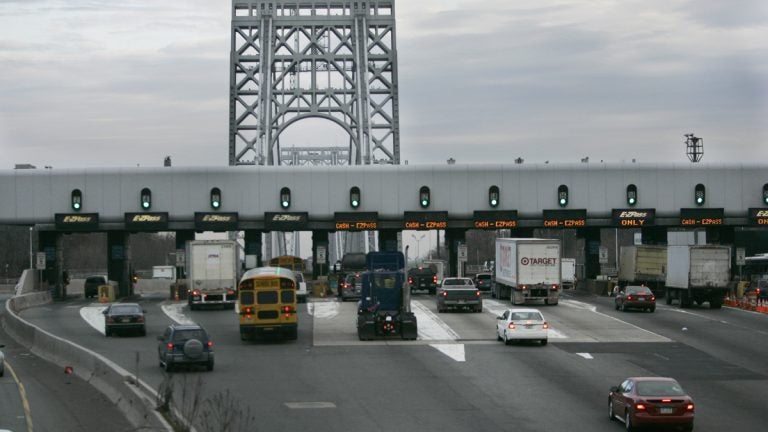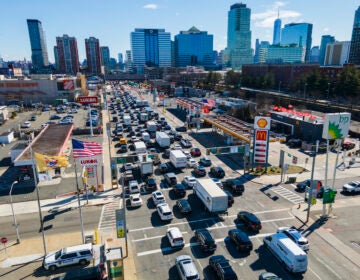How a highly politicized Port Authority made the GWB scandal possible

Cars approach the toll booth at the George Washington bridge in Fort Lee, N.J. (AP File Photo/Mary Altaffer)
The Bridge-gate scandal that forced the resignations of two of Gov. Chris Christie’s Port Authority appointees was the inevitable result of divided leadership, growing patronage, and increased gubernatorial meddling in the operations of the multibillion-dollar New York-New Jersey agency, transportation experts said yesterday.
In fact, Jameson W. Doig, who wrote the definitive history of the Port Authority, warned almost two years ago of the dangers inherent in the growing “politicization” of the bistate agency. He also cautioned against the transformation of its 12 commissioners into “obedient assistants to the governors, passively accepting patronage appointments and whatever actions fit a governor’s short-term political needs.”
Doig said yesterday he was not surprised by the growing scandal that has enveloped the Port Authority, the mega-agency that oversees airports, bridges, tunnels, ports, the PATH light-rail system, and the World Trade Center in New York and New Jersey.
The scandal has already forced the resignations of Christie’s top two operatives at the Port Authority — Deputy Executive Director Bill Baroni and Interstate Projects Director David Wildstein. It has sparked a series of subpoenas and legislative hearings, and has been seized on by Democrats nationally to attack Christie, the GOP frontrunner for president in 2016.
Four days in September
Wildstein, a high school friend of Christie, created traffic havoc in Fort Lee for four days in September by closing two dedicated lanes heading into the George Washington Bridge for a phantom “traffic study.” He also ordered his subordinates not to inform the Port Authority Executive Director Patrick Foye, who is an appointee of New York Democratic Gov. Andrew Cuomo, or Fort Lee Mayor Mark Sokolich.
Sokolich, a Democrat who had refused GOP requests to endorse the Republican Christie for reelection a few weeks earlier, wrote to Port Authority officials at the time that he believed the lane closures were “punitive,” but has declined to discuss the issue since then.
“I have been consistent in saying I have no comment,” Sokolich said last night. “I am still concerned about my community, and I am watching the results of the fact-finding investigation closely. For now, I have no comment.”
David J. Gallagher, president of the Port Authority Retirees Association, and Martin E. Robins, director emeritus of the Alan J. Voorhees Transportation Center at Rutgers University’s Bloustein School of Planning and Public Policy, joined Doig in criticizing Wildstein’s lane closures as unprecedented. They consider the episode to be symptomatic of the way patronage appointees answer to the interests of the governors who appoint them, rather than the transportation needs of the region as a whole.
“This is a colossal misdeed, a clear case of malfeasance in office, and an unprecedented abuse of power by David Wildstein and Bill Baroni at least,” said Robins, who asserted that such an action would have been unthinkable when he served as an executive at the Port Authority from 1983 to 1987. “People who worked at the Port Authority must be agog that anyone would do this. Clearly, it was a rogue act by a rogue employee, but he obviously knew he could get away with it.”
Gallagher, who retired as assistant director of tunnels, bridges and terminals – “the very group that is under investigation today” — said he had never heard in 33 years at the Port Authority or in his subsequent retirement of “tunnel or bridge lanes being closed for construction, rehabilitation, or any other purpose without well-orchestrated advance notice to newspapers, affected municipalities and police departments, and the commuter themselves.”
“It has never been done without advance notification,” Gallagher said. “The Route 495 helix into the Lincoln Tunnel is a good example. When the helix project was first being talked about, Mr. Baroni and others went door-to-door in local communities notifying people about the noise from construction and the lane closures that would be coming. This is the only case I know of in which public notice was consciously restricted, and there was no good reason for it.”The failure to notify Mayor Sokolich and the Fort Lee Police Department runs “completely contrary to the Port Authority’s traffic engineering ethos, which historically and traditionally pays an enormous amount of deference to making sure everyone in local government is fully briefed,” Robins said.
“(For Wildstein) to make Port Authority employees promise not to tell local officials makes it clear this was willful, malicious misdeed because there is no other reason to go forward without briefing local officials,” Robins added.
Doig, a professor at Princeton and Dartmouth universities who wrote “Empire on the Hudson: Entrepreneurial Vision and Political Power at the Port of New York Authority,” shared Robins’ dismay at Wildstein’s assumption that he could unilaterally close traffic lanes and order his subordinates to conceal his actions from the agency’s executive director.
“This is what happens when you have Gov. Christie forcing more than 60 patronage people on the Port Authority, including this most infamous David Wildstein,” Doig said. “Ever since then, the Port Authority’s leadership has had to deal with the problem of uncertain competence, and the fact that these are the governor’s people and cannot be readily removed or given orders to.
“You saw that clearly in this situation where the executive director, Pat Foye, did not feel he could remove Wildstein even after what he did. The Port Authority is plagued by divided leadership, and we have a governor in New York (Cuomo) who doesn’t care very much about protecting the quality of management at the Port Authority or trying to block Christie from enacting his own plans,” Doig asserted.
Foye ordered the Fort Lee lanes reopened on September 13 after receiving Mayor Sokolich’s letter, but emails reportedly showed that Baroni interceded with Foye not to go public with his belief that Wildstein had acted improperly and possibly illegally. It was not until October 16, the day of the special U.S. Senate election won by Cory Booker, that the Port Authority announced it was convening an internal review of Wildstein’s action.
And it was not until last Monday — a full month after Christie’s landslide reelection — that Foye testified under subpoena before the Assembly Transportation Committee that the closures were improper, and that he knew of no traffic study, contrary to Baroni’s testimony two weeks earlier. Wildstein had already resigned three days before Foy’s testimony, and on Friday, Christie announced that Baroni had resigned too.
Christie spent more than an hour answering questions at a Statehouse press conference in an effort to put an end to what were now a barrage of negative stories. The governor acknowledged that “mistakes were made.” He denied Friday that he had called Cuomo to ask him to have Foye stop trying so hard to get to the bottom of the Bridge-gate scandal, but the Wall Street Journal was standing by its report of the phone call.
Christie is hoping that the Bridge-gate controversy will go away quickly now that both Wildstein and Baroni have resigned. But Assembly Transportation Committee Chairman John Wisniewski (D-Middlesex) said he was far from getting answers to his many questions about the Port Authority scandal, and his committee issued seven additional subpoenas for documents and communications last week.
While Christie insisted previously that he makes “no apologies about trying to put some people in place who are going to understand what the view of this administration is,” Gallagher said that when governors insist on “having their own eyes and ears throughout the organization, their loyalties are not to the organization and its mission, but to the governor who put them there. It’s just a fact of life.”Consequently, the Port Authority functions today “like two separate organizations side-by-side, where the deputy director answers not to the executive director who is supposed to be his boss, but to the governor who appointed him. And the executive director doesn’t have the power to fire his own subordinates,” Robins said.
“The executive director and deputy executive director have to work as a team, be on the same page, and have a common agenda, and that’s the way it worked when I was at the Port Authority,” said Gallagher. “It didn’t matter who the governor was in either state, or which party he was from. Everybody worked for the good of the region.
“Today, you have divided management, and it’s like having a president of the United States from one party, and a vice president from the other one,” he said.
Gallagher, a resident of Somerset, added that “the notion of the Port Authority being a bistate agency on regional issues seems to be taking a back seat to the parochial views of one state or another.”
“We see $1.8 billion in Port Authority funds being siphoned off to rehabilitate the Pulaski Skyway,” he noted. “It’s not a Port Authority facility, and it’s not a proper use of Port Authority funds. It’s a convenient use for Christie because he hasn’t done anything to replenish the Transportation Trust Fund, and he got the money by killing off a new rail tunnel project that was a regional project and he has made no effort to come up with a replacement. But it fits the governor’s needs, so it goes through.”
Doig suggested in a February 2012 op-ed in The New York Times that the Port Authority has been unable to fulfill its mission properly because “the governors of New York and New Jersey have been unable to resist meddling in the day-to-day operations of this multibillion-dollar agency and unwilling to appoint members to the authority’s board of commissioners who will use their independent judgment to carry out a sustained program of critically needed transportation improvements without continual political interference.”
Those actions, Doig said, are contrary to the goal of those who created the Port Authority in 1921. The agency was designed to be “insulated from patronage demands and other short-term political pressures generated by mayors, legislatures and the governors themselves” by having each governor appoint six commissioners for six-year terms. That would mean their terms would run longer than the terms of the governors who appointed them and would prevent new governors from stacking the commission with friends and party loyalists.
For its first 75 years, Doig asserted, the Port Authority operated efficiently and professionally with minimal political interference. By tacit agreement, the New York governor appointed the executive director and the New Jersey governor the commission chairman, but the chairman and the executive director worked together smoothly to set policy.
However, increasingly, over the last decade or so, governors from both states have bypassed the 12 Port Authority commissioners and insisted on their own choices for executive director or deputy executive director, Doig said.”As a result, there have been seven executive or acting executive directors in the past 10 years,” he wrote, “hindering the authority’s ability to maintain a steady course,” particularly with the “management confusion” created by having the executive director and deputy executive director answering to different governors, and not to the Port Authority commissioners as a group.
The answer, Doig asserted, is for the 12 commissioners to begin to exercise their independent judgment, using the power granted them under the interstate compact that created the Port Authority. But the idea that Christie’s or Cuomo’s political appointees will be willing to buck the governors who appointed them seems unlikely.
“We really need to address the structural reforms needed to make the Port Authority able to function better and independently,” Robins said. “Because right now, the structure we have simply isn’t working.”
_____________________________________________________
NJ Spotlight, an independent online news service on issues critical to New Jersey, makes its in-depth reporting available to NewsWorks.
WHYY is your source for fact-based, in-depth journalism and information. As a nonprofit organization, we rely on financial support from readers like you. Please give today.




